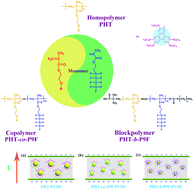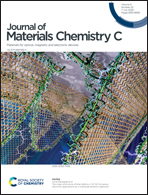Enhanced permittivity in polymer blends via tailoring the orderliness of semiconductive liquid crystalline polymers and intermolecular interactions†
Abstract
Dielectric polymer blends have attracted extensive attention in the modern electric power supply and renewable energy systems due to their good processability, high flexibility and light weight. However, it is challenging to improve the dielectric constant of polymer blends. In this work, three kinds of p-type semiconductor side-chain triphenylene discotic liquid crystalline polymers, namely, a homopolymer (PHT), copolymer (PHT-co-P9F) and block copolymer (PHT-b-P9F) were synthesized by traditional radical polymerization and reversible-addition–fragmentation chain transfer methods (PHT is poly{2-[3,6,7,10,11-pentakis(hexyloxy)-2-oxytriphenylene]methacrylate} and P9F is poly[2-(perfluorobutyl) ethyl methacrylate]). Polymer alloy films were fabricated by blending the three polymers with poly(vinylidene fluoride) (PVDF) in solutions. The compatibility and dielectric properties of a series of polymer alloys were studied. The results show that the dielectric properties of the polymer blends are related to the orderliness of PHT and the compatibility between PHT and PVDF. Among the three kinds of polymer blends, the compatibility between PHT-b-P9F and PVDF is the best because F–H bonding is formed between P9F and PVDF, which greatly improves the dielectric properties of the PHT-b-P9F/PVDF polymer alloys. At the content of 50 wt% PHT-b-P9F, the maximum dielectric constant of PHT-b-P9F/PVDF under 100 Hz is 35.5, which is 4.23 times higher than that of pure PVDF. Besides, compared with the dielectric loss and conductivity of the other two polymer alloys, the dielectric loss and conductivity of the PHT-b-P9F/PVDF polymer alloys show no obvious change. As for the PHT-co-P9F/PVDF blend films, they present the lowest dielectric constant owing to the lowest orderliness of the copolymer. These experimental results can be explained by interfacial polarization, which is associated with the interfacial area and charge carrier density. This study not only provides a new approach to synthesize the polymer blends with high dielectric constants, but also enables a deeper understanding of the effect of interfacial polarization on the dielectric performance.



 Please wait while we load your content...
Please wait while we load your content...